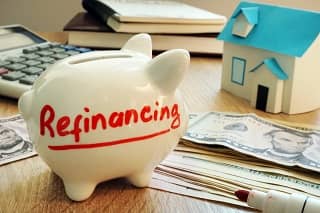 There are many reasons to refinance. But if your goal is to save money, you should consider refinancing from a 30-year to a 15-year mortgage. A 15-year mortgage save money two ways and builds home equity faster.
There are many reasons to refinance. But if your goal is to save money, you should consider refinancing from a 30-year to a 15-year mortgage. A 15-year mortgage save money two ways and builds home equity faster.
The following is a description of four potential benefits of refinancing into a shorter-term loan like a 15-year mortgage.
See today's 15-year mortgage rates
You get a lower interest rate
Here's fundamental fact about loans: the longer someone lends you money, the longer their money is at risk. For this reason, longer loans typically charge higher interest rates than shorter-term ones.
You can see this with 15-year mortgage rates and 30-year rates. Mortgage financing firm Freddie Mac has data on both types of loans going back to 1991. Since then, 30-year rates have been higher than 15-year rates by an average of 0.55%.
The difference between two rates is often a called a spread. Historically, the spread between 30-year rates and 15-year rates has ranged anywhere from 0.20% to 1.00%. So, even though the rate advantage for 15-year rates has varied over time, these loans have always been cheaper than 30-year rates.
Note that if you currently have a 30-year loan, this spread between 30-year and 15-year mortgage rates can mean there may be an opportunity for you to lower your rate by refinancing even if there has been little or no change in 30-year rates since you originally got your mortgage.
Related: How Much Lower Should Mortgage Rates Be to Refinance?
You save interest
Besides potentially lowering your interest rate, there is a second way refinancing to a 15-year mortgage can save you money. It can drastically cut the amount of time for which you pay interest.
Obviously, choosing a 15-year mortgage rather than a 30-year loan means paying interest for half as long. What might be less obvious is the shorter loan should actually cut your interest expense by more than half. And you'll be happy to see that your 15-year payment is less than double your 30-year payment.
That's because of the way amortization works. Your interest expense falls each months as the balance does. And more of each payment goes toward reducing the balance each month. Your balance decreases much faster with a 15-year loan, and so does your interest cost.
Related: Refinance When Rates Dip
You build equity faster
A shorter mortgage helps you build equity in your home more quickly, in two ways:
- First of all, a shorter repayment period means you will have your loan paid off sooner
- Second, the lower interest expense of a shorter loan means more of each payment builds your home equity and reduces your balance
What's the benefit of building equity faster?
Having equity in your home can increase your flexibility when it comes to future financial decisions. For example, you are much more likely to get approved for refinancing again if you have equity in your home. In some cases, having more home equity can mean qualifying for a lower refinance rate.
You also have access to home equity if you need to borrow for investment or to cover a financial emergency.
Finally, it's easier to sell and move if you need to when you have home equity. Your sale proceeds can pay off the existing mortgage and the extra can go toward the down payment on the next house you buy.
Building up a cushion of equity faster can be especially valuable when home prices decline. That equity cushion can make the difference between having the flexibility to refinance, borrow against home equity or move. Instead of being stuck with a house that is worth less than your mortgage balance.
Related: Calculate, track and forecast your home equity
You accelerate repayment
Assuming you've been paying down your mortgage for a while, a shorter-term mortgage may well be a better fit for refinancing than taking out a mortgage of the same length as your original loan.
For example, let's say you have been paying off a 30-year mortgage for 10 years. What you have left is effectively a 20-year loan. Which is a better match for that 20-year repayment period you have remaining: refinancing back to a new 30-year loan, or choosing a 15-year loan?
If you got your mortgage ten years ago, the average rate for a 30-year mortgage was 4.77%. if your loan amount was $200,000, your payment would be $1,046. After ten years, your balance would be $161,545. So, let's look at two options available today from one national lender -- a 30-year loan at 2.750% and a 15-year loan at 2.25%.
With the 30-year mortgage, you get:
- Payment of $659 (about $391 less)
- Increased time to repay of ten years
- A reduction in total interest expense only $13,551 (from which closing costs would be subtracted)
While with a 15-year mortgage, you get:
- Payment of $1,058 (about $12.50 more)
- Reduced time to repay by five years
- Decreased interest expense of $60,482
So if increasing your available cash is paramount, the 30-year refinance does that better. But if saving $60,000 in interest and becoming mortgage-free faster is your goal, the 15-year loan accomplishes this for almost the same monthly payment you have now.
Related: Calculator: Should I refinance my mortgage?
This article was revised and updated by Keith Gumbinger.



